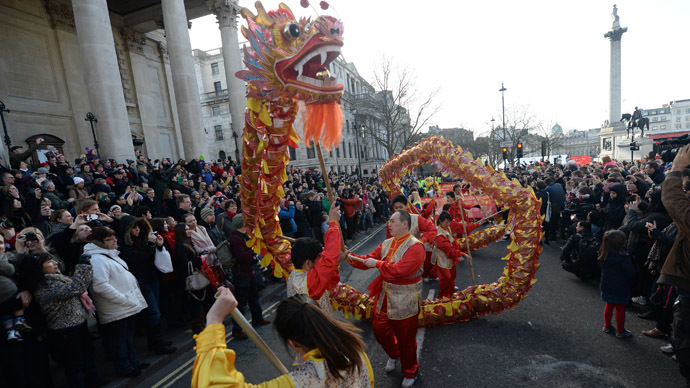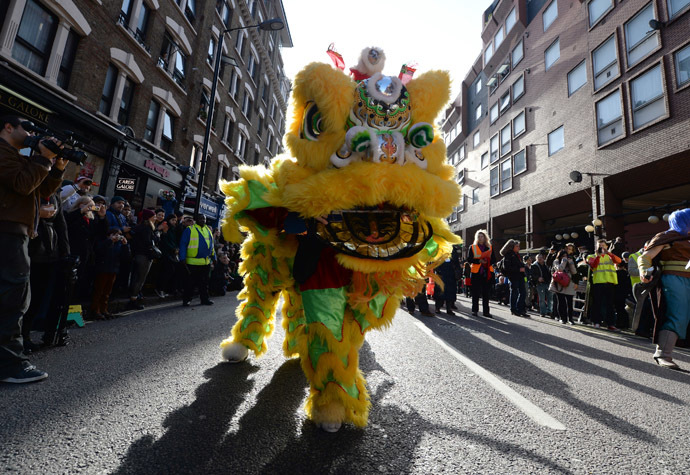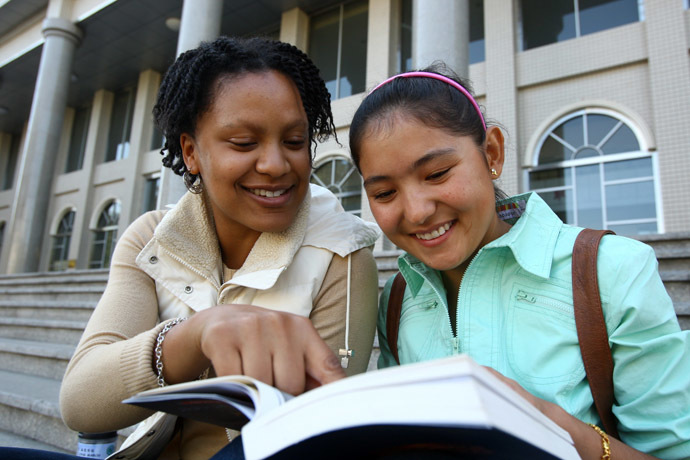Charm offensive: The way China influences the world

The far-flung celebrations of Chinese New Year around the world are a reminder of how growing popularity and expanding international recognition of Chinese culture and traditions demonstrate the progress of China's soft power.
A huge number of people around the world are celebrating the Chinese New Year or Chinese Spring Festival, which lasts several days. The popularity and influence of this festival has reached beyond China and Chinatowns and has become an expected event not only for the Chinese. London's Trafalgar Square hosts one of the biggest Chinese Lunar New Year celebrations in Europe every year, with the last year alone witnessing nearly half a million international visitors to the event.
“These celebrations are a reminder too of the richness and vibrancy of Chinese culture here in the UK, and on this New Year, I want to pay tribute to the incredible contribution that the British Chinese community makes to this country,” UK Prime Minister David Cameron said during his festive speech on January 29, sending warm wishes to all those who celebrate the Chinese New Year.
According to the Chinese ambassador to Britain, Liu Xiaoming “Chinese culture is gaining increasing acceptance overseas, which in itself attests to China's progress with a burgeoning foreign appetite to know more about China.”
‘China, all rights reserved’
According to the idea of the main theorist of “soft power” concept, Joseph S. Nye Jr., “soft power” is as an ability to co-opt people, to achieve political ends through attraction rather than coercion or payment. In other words, while “hard power” rests on threats (sticks) and inducements (carrots), “soft power” relies on the ability to shape the agenda in world politics, based on one’s principles and ideas, in other words, it is power of attraction.
Once a “sleeping giant,” nowadays China is the world’s fastest growing economy with a significant impact on other nations’ development. Though debates mainly revolve around economic and military aspects of China’s increasing power, its “soft power” components are considered to be an integral part of its influence. In fact, Chinese interpretation of “soft power” covers not only cultural instruments but economic and diplomatic ones as well, which in turn provides better opportunities to exercise its impact.
The specter of soft power instruments is rather large; it includes culture, language, public diplomacy, education systems, various festivals and big events. Indeed, the Olympic Games held in 2008 and the Shanghai World Expo of 2010 were important events, which assisted in enhancing public diplomacy and promoting China’s brand.
China's record spending on the Olympics, estimated at a total of $42 billion, which is a large sum for a developing country, especially in comparison with the Athens Olympics budget of $15 billion in 2004 and the London Olympics coming in at $35 billion in 2012. Beijing considered the Olympic Games to be very important in the sense of public diplomacy, particularly in creating the image of a “nice country,” which is favorable to everyone. However, Western countries failed to understand the Chinese message, since there is a sharp difference in Western and Chinese values. Besides, even before the beginning of the Games, critics attacked China on issues ranging from human rights to food safety and the environment. Furthermore, some human rights groups called on the US and the European Union to react more forcefully and boycott the 2008 Olympics.

Learn Chinese
The most crucial components of Chinese soft power are its culture and language, which is why enhancing the educational sector became critical for the Chinese authorities. In the 1990s, the government launched the 211 Project, the largest investment ever in the improvement of 100 universities and 100 key disciplines. And there was the 985 Project, aimed at allocating funds to a number of elite universities. These initiatives resulted in an unprecedented expansion of China’s higher education: if in 1999 the number of new enrolled students was 1.3 million, in 2006 it skyrocketed to 5.4 million. At the same time, Beijing focused on creating favorable conditions for foreign students, including a growing number of exchange programs and grants for studies.
Whereas in 1992 only 13,000 foreign students studied in China, in 2000 this number jumped to 52,200 and reached 162,700 in 2006. The number of foreign students coming to study in China continues rising: in 2011 it set a new record of 292,611 students from 194 countries. Over 75 percent of students are from Asia, with South Korea and Japan consistently sending the most. What is important is the fact that previously the US was the most favorite direction for Southeastern Asian youth, but now there is a remarkable shift towards Chinese education. For example, 2,563 Indonesian students entered China in 2003, which is a 51 percent increase over the previous year. By contrast, only 1,333 Indonesian students were enrolled in education programs in the US the same year, a precipitous drop from the 6,250 student visas issued in 2000. South Korea sends more than 13,000 students to China every year, which is equal to the total number of Korean students in America from 1953 to 1975, at the height of relations between these states.
Beijing has also organized classes in Mandarin and Chinese culture in overseas primary schools and signed agreements with countries like Thailand to help integrate Chinese into public schools’ curricula. Besides, the Chinese government sends hundreds of instructors to schools in various countries like Cambodia, Kenya and Argentina. In general, Chinese language schools provide a better education, at a lower cost, with less corruption, which partly explains their popularity. However, while China is becoming a popular destination, the United States continues to attract far more students: in 2011 more than 722,000 international students came to America, which is 2.5 times higher than Chinese indices.
Recognizing the importance of language in increasing cultural attractiveness, China has been aggressive in promoting the study of Chinese all over the world. In 2004, the Chinese government unveiled a plan to open 500 Confucius Institutes throughout the world by 2010. By late 2005 the Chinese Ministry of Education had set up 32 Confucius Institutes in 23 countries in order to provide Chinese language and cultural resources to host countries. Confucius Institutes have not only educational purposes but political ones as well: to further a kinder and gentler image of China to the world. For example, in Africa there are more than 50 Confucius institutes and Africans are willing to learn the Chinese language, considering it as an opportunity to have a better life.
Furthermore, by teaching Beijing’s preferred version of Chinese and utilizing readings from a Beijing perspective, rather than traditional Chinese characters used in Macao, Hong Kong and Taiwan or Taiwan-based points of view, the Institutes also serve to advance China’s foreign-policy goal of lessening Taiwan’s international influence. The number of Confucius Institutes reached 155 by May 2007 and multiplied to 209 by November 2007. At the current time 400 Confucius institutes and over 500 Confucius classrooms have been set up in 108 countries. Moreover, the number of students taking all kinds of Chinese tests has amounted to 500,000.

‘Let China sleep, for when she wakes, she will shake the world’
Chinese ethnic diasporas in various countries of the world are also a tool of influence, since they advertise Chinese heritage, promote a good and peaceful image of China, as well as facilitate lobbying and doing business. During the last years, the Chinese government has rebuilt relations with ethnic Chinese organizations around the globe, from cultural associations to businessmen. Beijing also assists in organizing meetings, conferences, and summer camps for children from the Chinese diaspora.
In addition, media, namely the upgraded Chinese newswire Xinhua, overseas editions of the People’s Daily newspaper and international broadcasting of CCTV, a state-owned network of 22 channels, has colossal potential, although its influence lags behind Western media. Indeed, CCTV has been gaining more and more viewers since it started broadcasting in English, Spanish, Arabic, Russian and French. At the present time, CCTV has 7 channels operating abroad, with plans to launch a Portuguese channel in the near future.
All these resources complement China’s “Peaceful Development” strategy, the “Beijing Consensus” model, a concept of “win-win” relations, according to which African, Asian, Latin American and Arab states could benefit from cooperation with China as China benefits from relationships with them, and a “non-interference into internal affairs” strategy.
On January 1, Chinese President Xi Jinping vowed to promote China's cultural soft power by disseminating modern Chinese values and showing the charm of Chinese culture to the world.
“China should be portrayed as a civilized country featuring a rich history, ethnic unity and cultural diversity, and as an oriental power with good government, developed economy, cultural prosperity, national unity and beautiful mountains and rivers,” Xi said.
He also added that China should be marked as a responsible country that advocates peaceful and common development, safeguards international justice, and makes contributions to humanity. Moreover, it should be perceived as an open, amicable, promising and vibrant socialist country.
While the soft power concept is actively discussed among top Chinese officials and many efforts, as well as money, are being used to promote Chinese culture and traditions, some of the ways to increase Chinese presence in the world and attract more attention are frankly absurd.
For instance, Beijing is trying to “conquer” the Olympus of pop music and so signed its singer, Ruhan Jia, to the Earth's Music project, which was seen as so important that it's even said to have been included in the current five-year economic plan. Ruhan Jia isn’t the only musician who is trying to crack the international music market, although she is the one backed by the Communist Party. Another funny and cute example of how China is attempting to create a positive image is iPanda live 24/7 streaming, showing the life of pandas in China’s national parks. Indeed, pandas do attract a lot of public attention, but does it improve the world’s perception of China? Doubtful!
Irina Sukhoparova, RT
The statements, views and opinions expressed in this column are solely those of the author and do not necessarily represent those of RT.
The statements, views and opinions expressed in this column are solely those of the author and do not necessarily represent those of RT.











